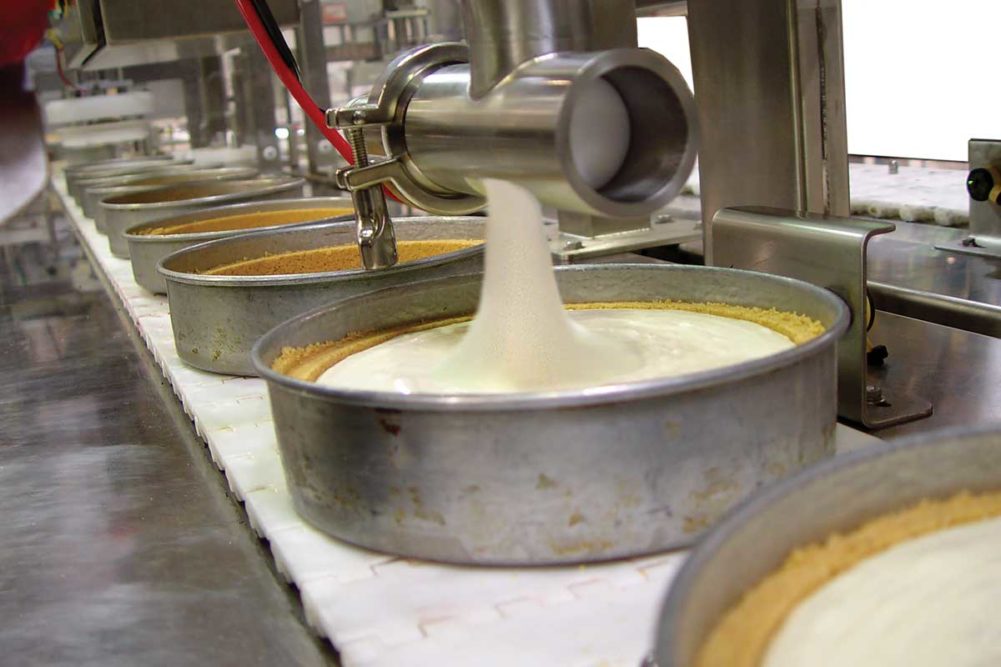Precision in depositing batters isn’t just about positioning and type of nozzle; it’s also about the weight to be deposited. This is called mass flow, and measuring it can be tricky.
ET Oakes controls mass flow through automatic feedback to its PLC system. Each row being deposited includes metering valves that regulate the final deposit weight across the manifold width. The system can automatically adjust the metering valves based on their performance or wear.
Bob Peck, vice-president of engineering, ET Oakes, described a 60-inch-wide manifold distributing batter across 20 rows. The metering valves act as a threaded plunger that can be adjusted to provide more or less batter. The valves are all balanced based on the air-pressurized system so that the same amount of batter comes out of each one. Once the metering valve measurement is set, it’s repeatable, Mr. Peck said. As another level of accuracy control, ET Oakes also uses mass flowmeters above the metering valves. When batter flows through these meters, they measure the mass flow by the second and adjust the pump accordingly.
“There’s feedback,” Mr. Peck explained. “So if we say we want 1,000 lbs per hour to our manifold and the mass flowmeter starts reaching 900 lbs per hour, it automatically speeds up the pump to maintain the 1,000 lbs.”
Handtmann uses its dividing machines to aid in measuring mass flow. Handtmann’s DS 551 depositing station, in conjunction with a VF 600B dividing machine, is suited for the dosing of spot, strip or continuous flow filling into cups, trays or pans. The batter is pre-portioned by the VF 600B, which was designed for batters and viscous products. They flow into and through Handtmann vane cells for precise measurement and are fed to the servo-driven flow divider through multiple lanes.
Depositing volume often may be recalled and measured through repeatable recipes. AMF Bakery Systems uses servo technology to deposit its recipe-driven weights accurately.
“With each new recipe selected on the touch screen, all settings are automatically set,” said Hans Besems, executive product manager for AMF. “Also, operators can easily adjust this by the touch screen if they want more or less batter for that product.”
Mr. Besems cautioned bakers to match the correct shutoff nozzle to the depositor based on the batter. This prevents batter leaks that can alter weight measurements.
Properly filling depositor hoppers also contributes to consistency. Unifiller developed Hopper Topper pumps that transfer all batters, including the most delicate, from mixing bowls to the hopper with simulated “hand scooping” technology.
“With automatic level-sensing technology in the depositor hoppers, they are an integral part of accurate and consistent batter depositing solutions,” said Andy Sigrist, director of special projects for Unifiller.
Not only are consumers searching for varied portion sizes, but they also crave innovation and indulgence. Inclusions are one way to accomplish this, but depositors need to stand up to the task.
Aiming true
Popular products like muffins, cakes and brownies often feature inclusions. Some are hard, such as nuts, while others are soft strands like carrots. Others like blueberries are delicate and can discolor a batter. Each deserves careful consideration when improving the flexibility of a line or a depositor.
To safely transport these inclusions through the hopper to the depositing valves and onto the pan, the batter needs a wide flow path.
“Carefully designed large openings and smooth transitions within Unifiller depositors and nozzles guarantee the most efficient and delicate handling of the batters to ensure they are deposited with consistent integrity and the most accurate portioning possible,” Mr. Sigrist said.
Inclusions need to be protected and evenly distributed through batter. Reiser’s Vemag double-screw system transports products gently without crushing or smearing gentle inclusions. John McIsaac, vice-president of strategic business development, Reiser, said the company can match a double-screw system to any bakery application.
Air-pressurized systems also can accomplish gentle handling and even distribution. ET Oakes’ laminar flow design manifold eliminates areas where batter and inclusions can accumulate. The manifold, Mr. Peck said, has large orifices and spherical radii to improve batter flow for greater consistency.
“We designed it so that there are no dead zones,” Mr. Peck said. “Wherever we are bringing product in, we are guaranteeing to push that product out.”
Bakers need depositing systems that are fast, easy to changeover and always on target.
This article is an excerpt from the February 2020 issue of Baking & Snack. To read the entire feature on depositing, click here.

